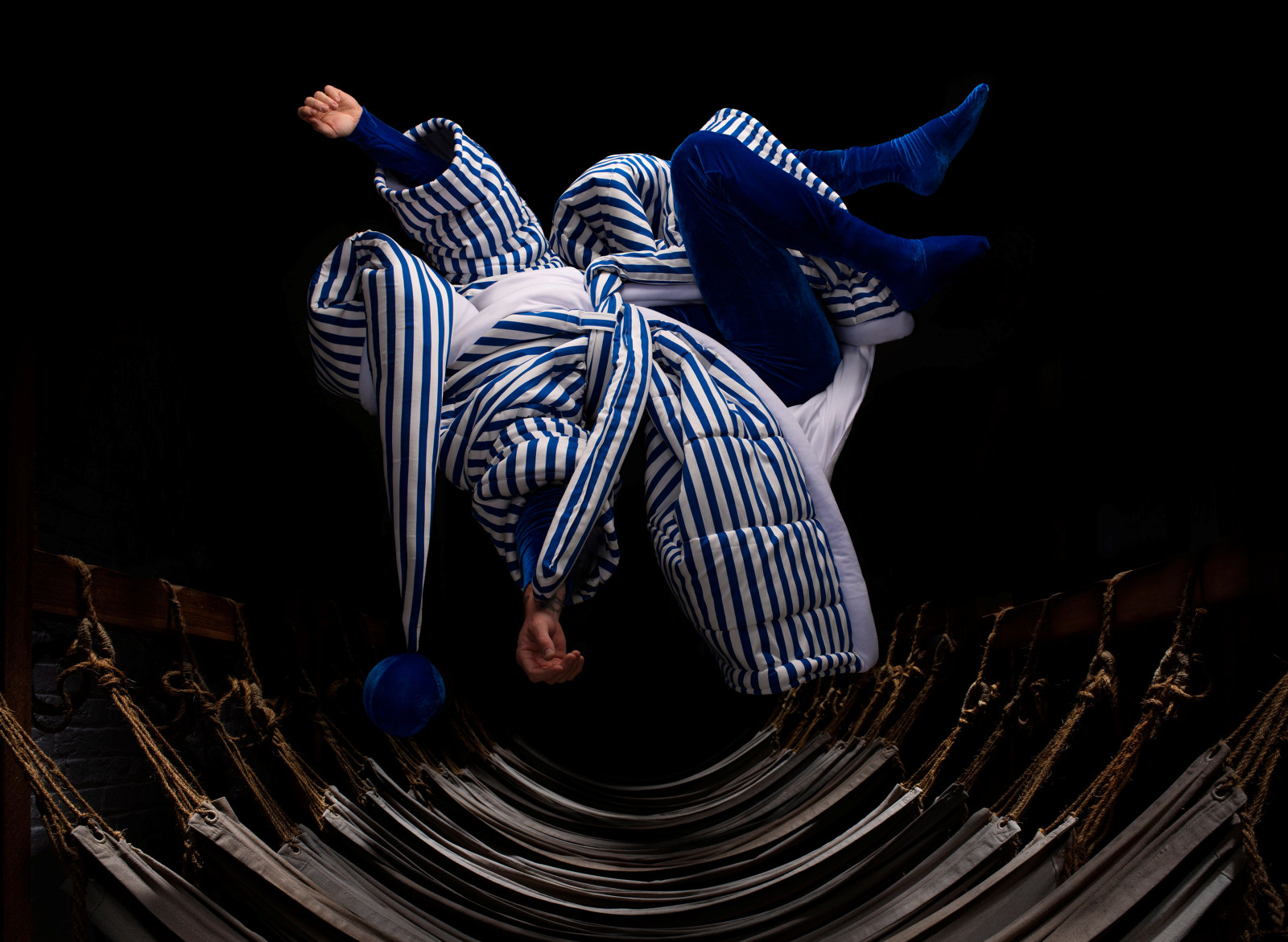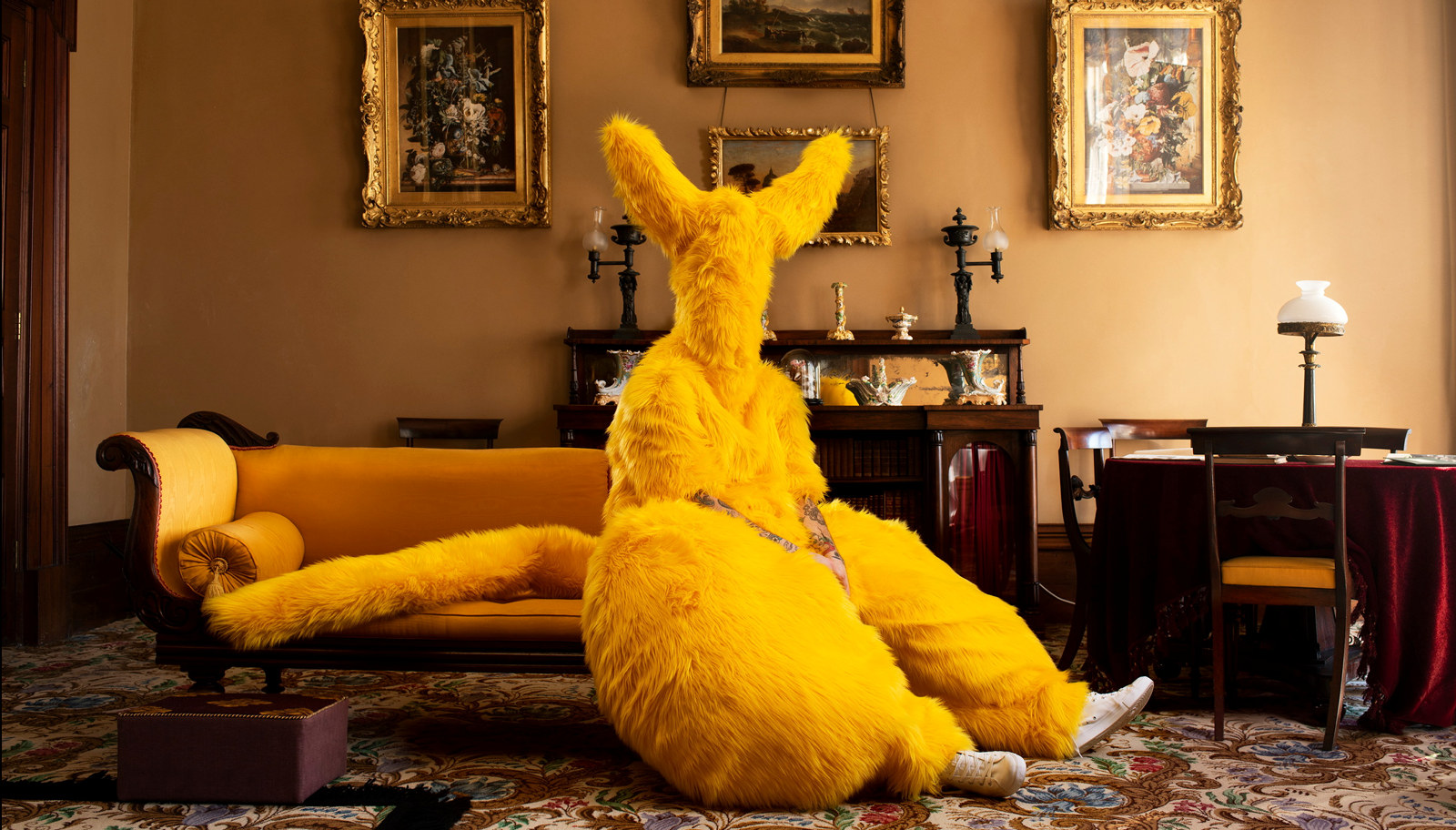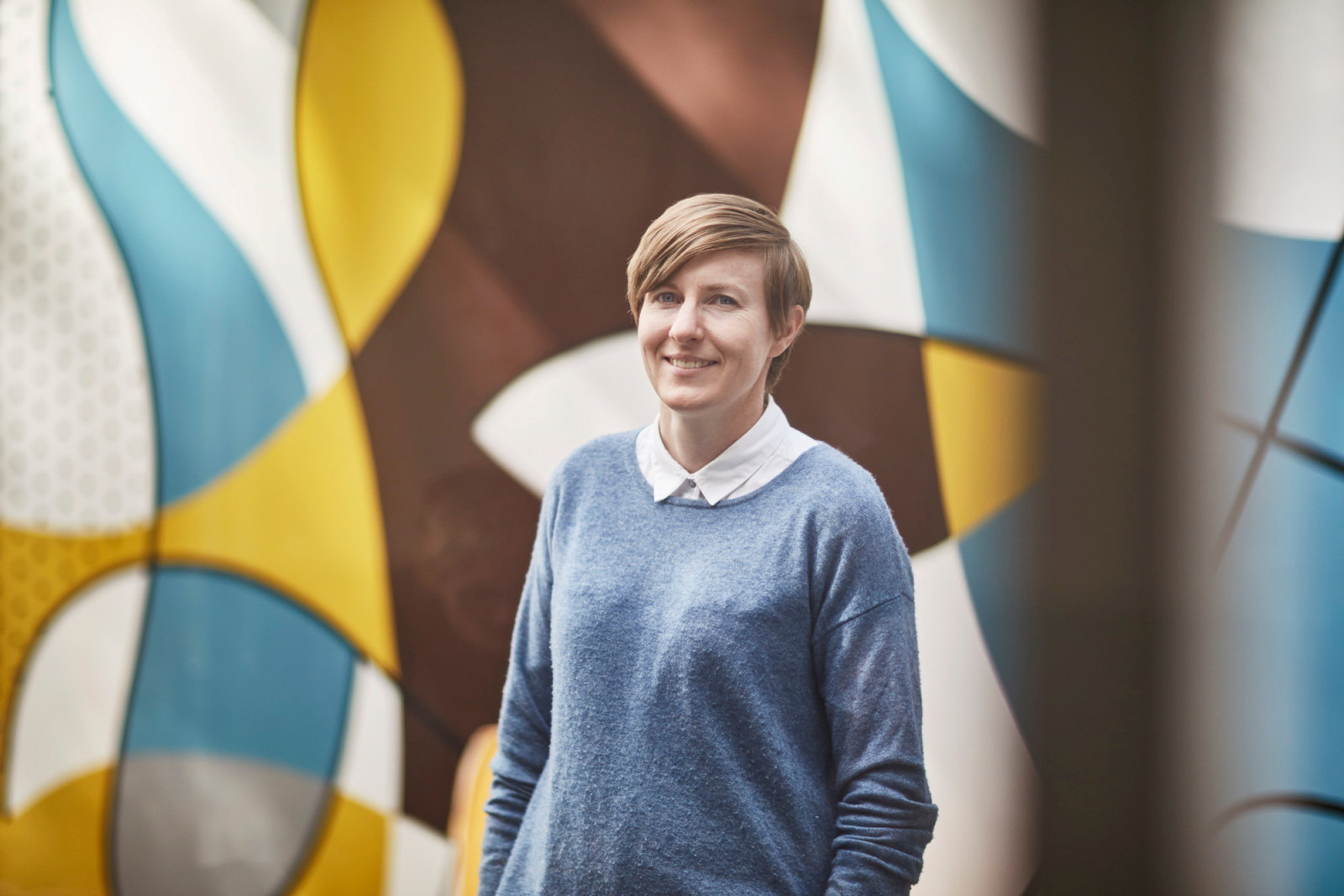Fabricating heroes: Iridescent by Gerwyn Davies
Museums of Historic NSW has commissioned photographic artist and costume maker Gerwyn Davies to launch our 2022 creative theme, ‘Life reimagined’, with Iridescent, an exhibition at the Museum of Sydney.
In this exhibition, Gerwyn Davies’s creations – from oversized queer creatures to fantastically costumed beings – invade our historic interiors and significant places. Uncanny and incongruous, the works in Iridescent seduce the viewer into looking more deeply at these sites and their associated narratives. We attempt to identify the familiar, yet we’re presented with the alien. This tension forms the crux of Davies’s photographic practice, at once alluring and repelling, inviting and denying. Iridescent draws attention to the multiple subjectivities that exist within museum spaces, and invites audiences to engage with history in a different way – less reverential, more playful, witty and liberating.
Q: How did the process of responding to these 12 unique properties differ from your usual practice, and what was your starting point for creating each image?
A: Typically, when I’m making an image, I gradually construct a fantasy world inside the photograph, adding and removing details and controlling every single element inside the frame. What starts as an image of a real location gets massaged into something more synthetic or fake. These are spaces that will never be physically encountered – as the viewer isn’t able to see around the corners of the photograph, the fantasy is never exposed for what it is. Iridescent was kind of a reversal of how I normally work. These MHNSW spaces exist; people are able to visit and experience them. I had to find a way to accentuate and celebrate these spaces while still trying to conjure that sense of fantasy and otherworldliness. It became a very interesting battle to resist my normal tendency to manipulate and manicure the image and make everything varnished, plastic and shiny. The nice thing about this process is that it gave me one less thing to think about – there were a certain set of fixed conditions I had to respond to. If I couldn’t alter these spaces through photo manipulation, I had to think about how I could use lighting to shift the way the spaces normally appear.
I started the process by heading out and inspecting all of the sites so I could get an idea of them as a collection before considering them individually. As the sites were the one thing I wasn’t looking to manipulate, I thought about them as stages on which I could construct and perform these spectacles. I read through the established histories of each place, about the people who lived in those spaces and the key events that happened there, while also keeping a keen eye out for their lesser-known histories, inferences or unexpected subplots. For most of the sites there was an actual historical figure I was in conversation with in producing the work, but ultimately the details got lost as I diverted their story in new directions. So the final work at Vaucluse House isn’t about Sarah Wentworth, for instance, but there are elements of her story that I’ve drawn upon as a foundation to help spin off something new.
I was captivated by the objects presented throughout the houses – I’ve used these to inform the materials that I chose and the forms of the costumes that I constructed.
Each work is also propelled by a sense of the intangible. When you visit these historic sites and museums, you’re kind of looking through them rather than at them. You’re trying to imagine the cast of characters who lived in these places, to picture how they lived, so there’s a strange kind of seeing and unseeing. Because I knew that I was going to insert something – a drama, an event, a spectacle – into the space, I was looking through them to imagine what kind of queer creature was going to take over and occupy that space. And that was more informed by the sensation of being in a space, drifting around it and trying to envisage what kind of image would materialise from it.
Q: Your practice challenges the traditional understanding of portrait photography as a means of revealing a truth about the sitter, by instead presenting a subject who is ambiguous, who reveals but also conceals themselves. How important is this in your work?
A: It’s critical to my work. It’s a constant game that I’m playing with the viewer, a routine between myself and the camera, a disappearing act enabled through the elaborate costuming, as well as through photographic post-production. Traditionally, yes, photography was always involved a series of subjective decisions – about what’s included and what’s excluded, through framing or focus. I’m really interested in creating images where it’s not an either/or situation, where you’re either in the frame or out. I really like the idea of creating these very stubborn figures that conspicuously maintain a presence inside the image – they’re vivid and glittery – but at the same time they’re nowhere to be seen, they’re hiding in plain sight. I’m looking to create a prolonged tension where the viewer is searching for something in the image but is unable to access, identify or categorise who or what it is in the frame.
Photography is a medium predicated upon visibility, and the notion of representational visibility carries tremendous political weight. My practice and research, the field of photographic artists I’m drawn to and operate within, look for ways to invite more nuance into the equation of representational visibility, to complicate its terms and produce new queer states of being both seen and unseen by the camera at the same time. The potential for in/visibility and dis/appearance really underpins my whole interest in photography.
Q: Tell me about the exhibition title, Iridescent. As well as speaking to the materiality of your costumes, how does it relate to the idea of disrupting the traditional narratives found in museums, and particularly the idea of ‘queering’ museum spaces?
A: I set out to make images that would illuminate and celebrate queer stories of these MHNSW sites, but then I couldn’t find those histories – they didn’t exist in documentation. So it occurred to me that I just had to use elements of the museum collection to design my own, to think about how I could fabricate, construct and embellish my own ‘histories’. I discovered the use of the term ‘iridescent’ in relation to museum studies while researching the project. It describes the way history isn’t fixed or monochromatic but rather is in flux and is liable to shift depending on the viewer’s perspective. The term was perfect because it also resonates through the visual properties of the costume materials I use in this body of work – they shimmer, shift and sparkle, they attract the eye but at the same time deflect attention.
Iridescent is a term that invites new perspectives on institutions like museums that can feel impenetrable; it invites the potential for othered subjectivities to approach museums in their own ways, to consider the stories and objects in these collections as movable rather than fixed.
An important text for my research was Queering the museum by Nikki Sullivan and Craig Middleton (2021), which examines strategies for reorganising objects on display in museums to forge new relationships and conjure queer meanings. An object displayed on its own is constrained by its provenance and its cultural context, but when it’s placed alongside a seemingly unconnected object, inferences and insinuations can be made, new meanings provoked by considering the tale of these two objects together. My own approach to queering the museum is far less subtle, far more camp, irreverent and playful. I’m creating these elaborate queer creatures who break into and take over these spaces; they dramatically shift the context of the museum sites by transforming them into fantastic habitats of their own. It’s less about strategically rearranging objects to create allusions and more about jamming a 7-foot-tall lemon-yellow faux-fur creature into the specimen collection of naturalist Alexander Macleay at Elizabeth Bay House.
Q: What new light do you hope to shine on MHNSW’s places and stories?
A: I’d like to encourage people who maybe wouldn’t normally engage with these sites to visit them and consider them. I’d like visitors to think about how the history presented for them is a construction, and if they’re excluded from it, the creative ways in which they might engage with history – and, in the seeming absence of available heroes, to fabricate their own, which is what I’ve done. I’d like people to be seduced into engaging with these museums that otherwise might feel a little stuffy and cold, because these spaces belong to everyone. It’s exciting to think about how the spaces will be reinterpreted through this project, the ways they can be used and manipulated by other people who maybe have been left out of or erased from those histories.
Related

Gerwyn Davies photographs
View the 12 photographs which respond to the sites, histories and collections of the Museums of History NSW
Published on

